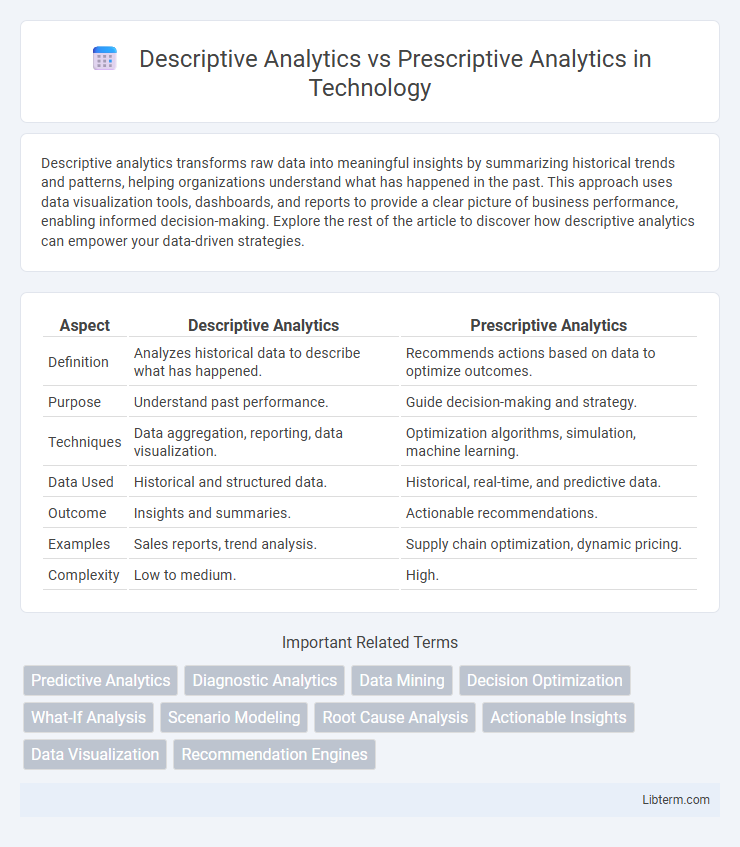Descriptive analytics transforms raw data into meaningful insights by summarizing historical trends and patterns, helping organizations understand what has happened in the past. This approach uses data visualization tools, dashboards, and reports to provide a clear picture of business performance, enabling informed decision-making. Explore the rest of the article to discover how descriptive analytics can empower your data-driven strategies.
Table of Comparison
| Aspect | Descriptive Analytics | Prescriptive Analytics |
|---|---|---|
| Definition | Analyzes historical data to describe what has happened. | Recommends actions based on data to optimize outcomes. |
| Purpose | Understand past performance. | Guide decision-making and strategy. |
| Techniques | Data aggregation, reporting, data visualization. | Optimization algorithms, simulation, machine learning. |
| Data Used | Historical and structured data. | Historical, real-time, and predictive data. |
| Outcome | Insights and summaries. | Actionable recommendations. |
| Examples | Sales reports, trend analysis. | Supply chain optimization, dynamic pricing. |
| Complexity | Low to medium. | High. |
Introduction to Descriptive and Prescriptive Analytics
Descriptive analytics focuses on analyzing historical data to identify patterns and summarize past performance through tools like dashboards and reports. Prescriptive analytics goes beyond by using advanced algorithms, simulations, and optimization techniques to recommend actionable decision options. Both approaches leverage data insights, with descriptive analytics explaining what happened and prescriptive analytics suggesting what should be done to achieve desired outcomes.
What is Descriptive Analytics?
Descriptive analytics involves analyzing historical data to identify patterns, trends, and insights, providing a clear understanding of past performance. It uses techniques such as data aggregation, data mining, and data visualization to summarize large datasets into meaningful information. This form of analytics supports decision-making by offering a comprehensive view of what has happened within a business or system.
What is Prescriptive Analytics?
Prescriptive analytics uses advanced algorithms, machine learning, and optimization techniques to recommend specific actions based on data insights. Unlike descriptive analytics, which summarizes past data trends, prescriptive analytics predicts potential outcomes and suggests the best course of action to achieve desired objectives. Industries such as healthcare, finance, and supply chain management rely on prescriptive analytics for decision-making and strategic planning.
Key Differences Between Descriptive and Prescriptive Analytics
Descriptive analytics focuses on summarizing historical data to identify patterns and trends, providing insights into what has happened in the past. Prescriptive analytics goes further by using optimization and simulation techniques to recommend actions for future decision-making based on predictive models. The key difference lies in descriptive analytics explaining past performance, while prescriptive analytics prescribes actionable strategies to achieve desired outcomes.
Use Cases for Descriptive Analytics
Descriptive analytics is primarily used for summarizing historical data to identify patterns and trends, making it essential in reporting sales performance, customer behavior analysis, and operational efficiency assessments. Retail companies rely on descriptive analytics to track inventory levels and understand purchasing patterns, enabling better stock management. Healthcare organizations utilize descriptive analytics to analyze patient records and treatment outcomes, supporting evidence-based decision-making and resource allocation.
Use Cases for Prescriptive Analytics
Prescriptive analytics enables businesses to recommend actionable strategies by analyzing data patterns and predicting outcomes, widely applied in supply chain optimization, personalized marketing, and risk management. Organizations use prescriptive analytics to enhance decision-making by simulating various scenarios and determining the best course of action, particularly in healthcare for treatment planning and in finance for portfolio management. By leveraging machine learning algorithms and optimization models, prescriptive analytics drives operational efficiency and competitive advantage across multiple industries.
Tools and Technologies Supporting Descriptive Analytics
Descriptive analytics relies heavily on tools such as data visualization platforms (Tableau, Power BI), SQL databases, and reporting software to aggregate and analyze historical data, providing clear insights into past performance. Technologies like Hadoop and Apache Spark enable processing large datasets for comprehensive descriptive analysis, while tools such as Excel and Google Analytics offer user-friendly interfaces for generating summary statistics and trend reports. These supporting tools help organizations make data-driven decisions by transforming raw data into understandable, actionable information.
Tools and Technologies Supporting Prescriptive Analytics
Prescriptive analytics leverages advanced tools such as optimization algorithms, machine learning platforms, and simulation software to recommend actionable decisions based on predictive insights. Technologies like IBM Decision Optimization, Google Cloud AI, and Microsoft Azure Machine Learning enable businesses to analyze complex datasets and generate prescriptive models that optimize outcomes. In contrast, descriptive analytics primarily relies on data visualization tools like Tableau and Power BI to summarize historical data without providing decision-making recommendations.
Challenges in Implementing Descriptive and Prescriptive Analytics
Implementing descriptive analytics faces challenges such as data quality issues, data integration from disparate sources, and ensuring accurate historical data interpretation. Prescriptive analytics implementation struggles with the complexity of developing robust optimization models, the need for real-time data processing, and aligning analytics recommendations with business objectives. Both approaches require significant investments in technology, skilled personnel, and continuous data governance to ensure effective decision-making.
Choosing the Right Analytics Approach for Your Business
Descriptive analytics provides insights into past performance by analyzing historical data, helping businesses understand what happened and identify trends. Prescriptive analytics goes further by recommending specific actions based on predictive models and optimization techniques, enabling companies to make data-driven decisions that improve future outcomes. Choosing the right analytics approach depends on your business goals: use descriptive analytics for performance tracking and reporting, and prescriptive analytics when you need actionable strategies to enhance operational efficiency and competitive advantage.
Descriptive Analytics Infographic

 libterm.com
libterm.com